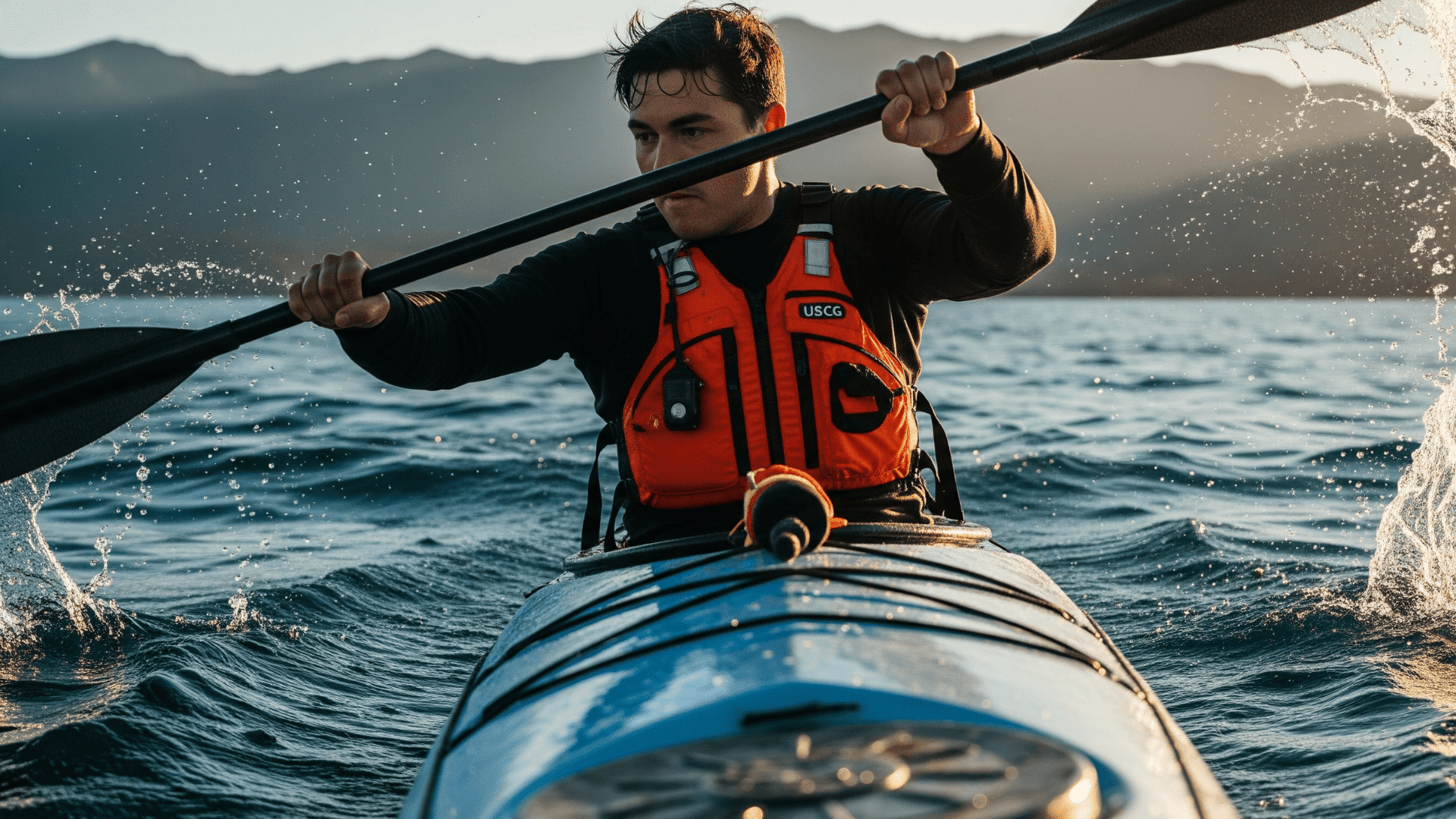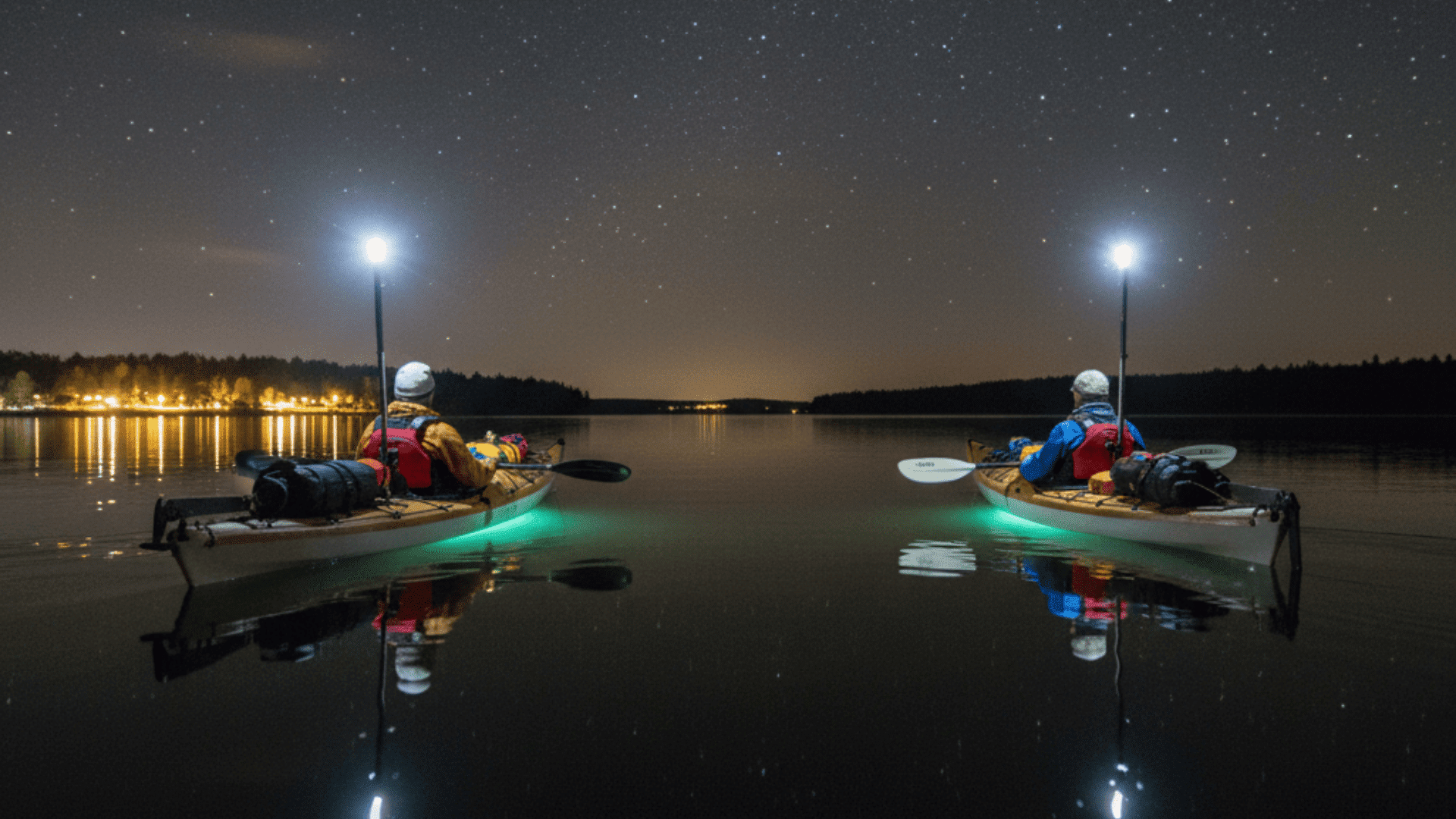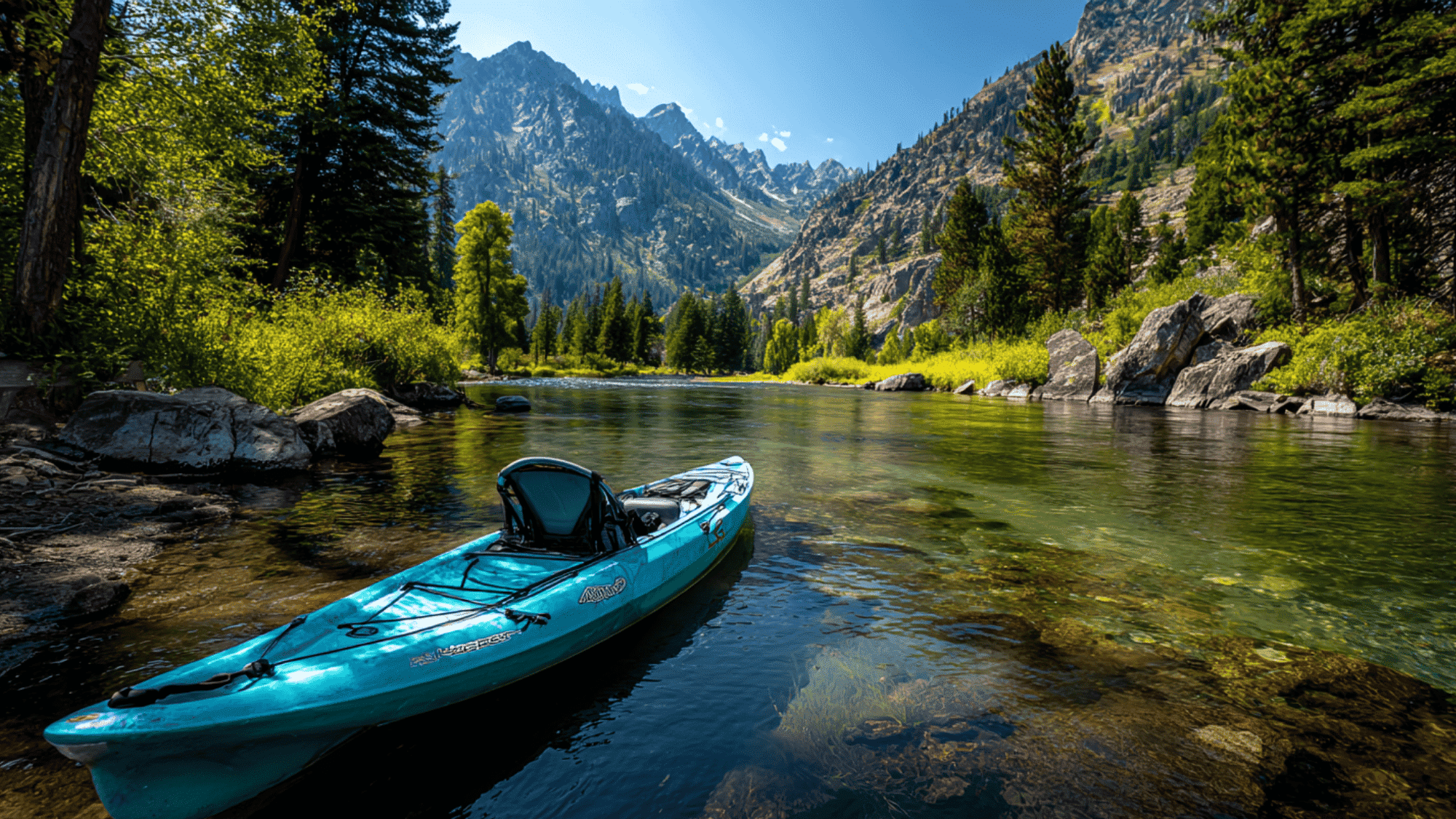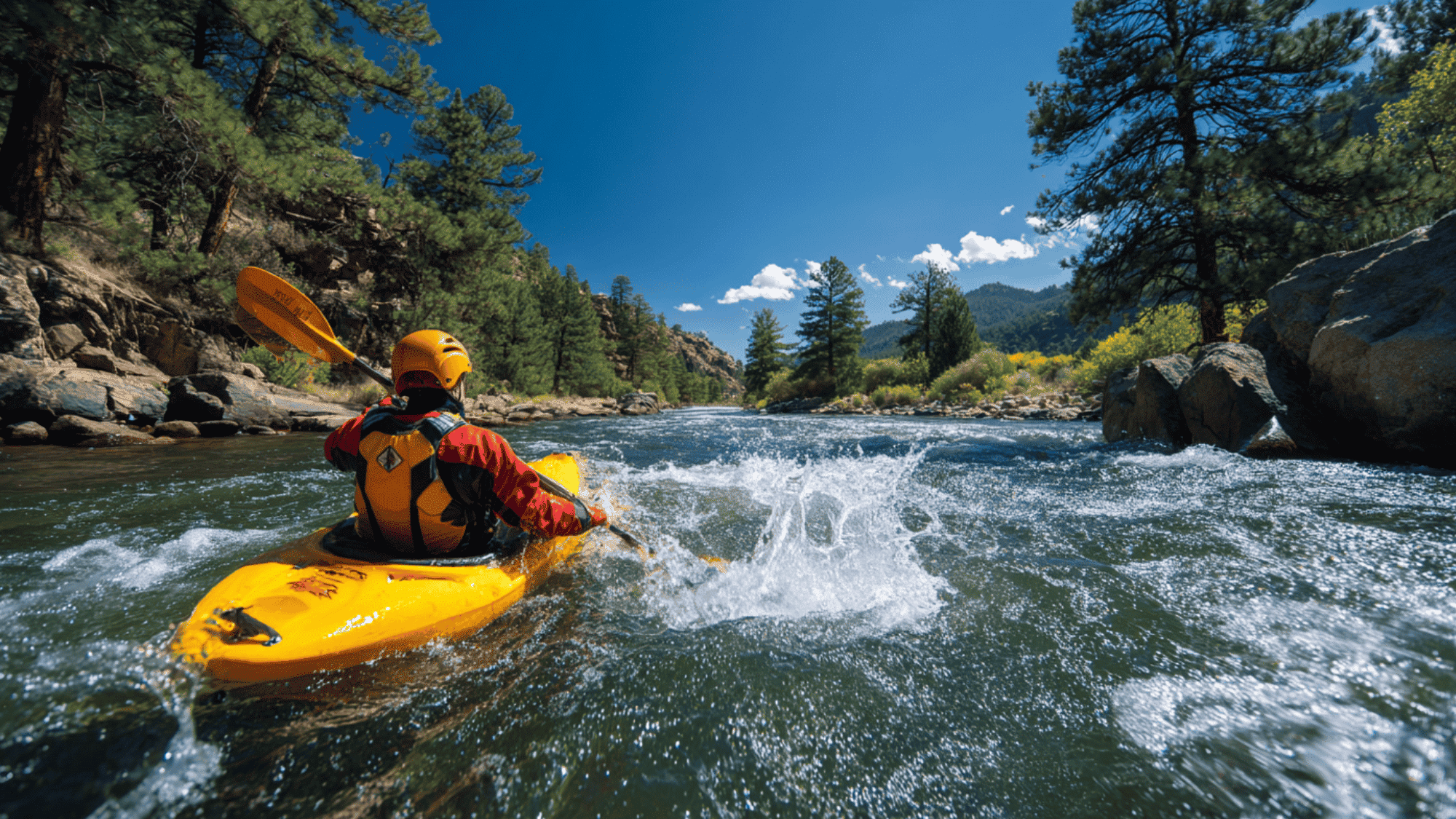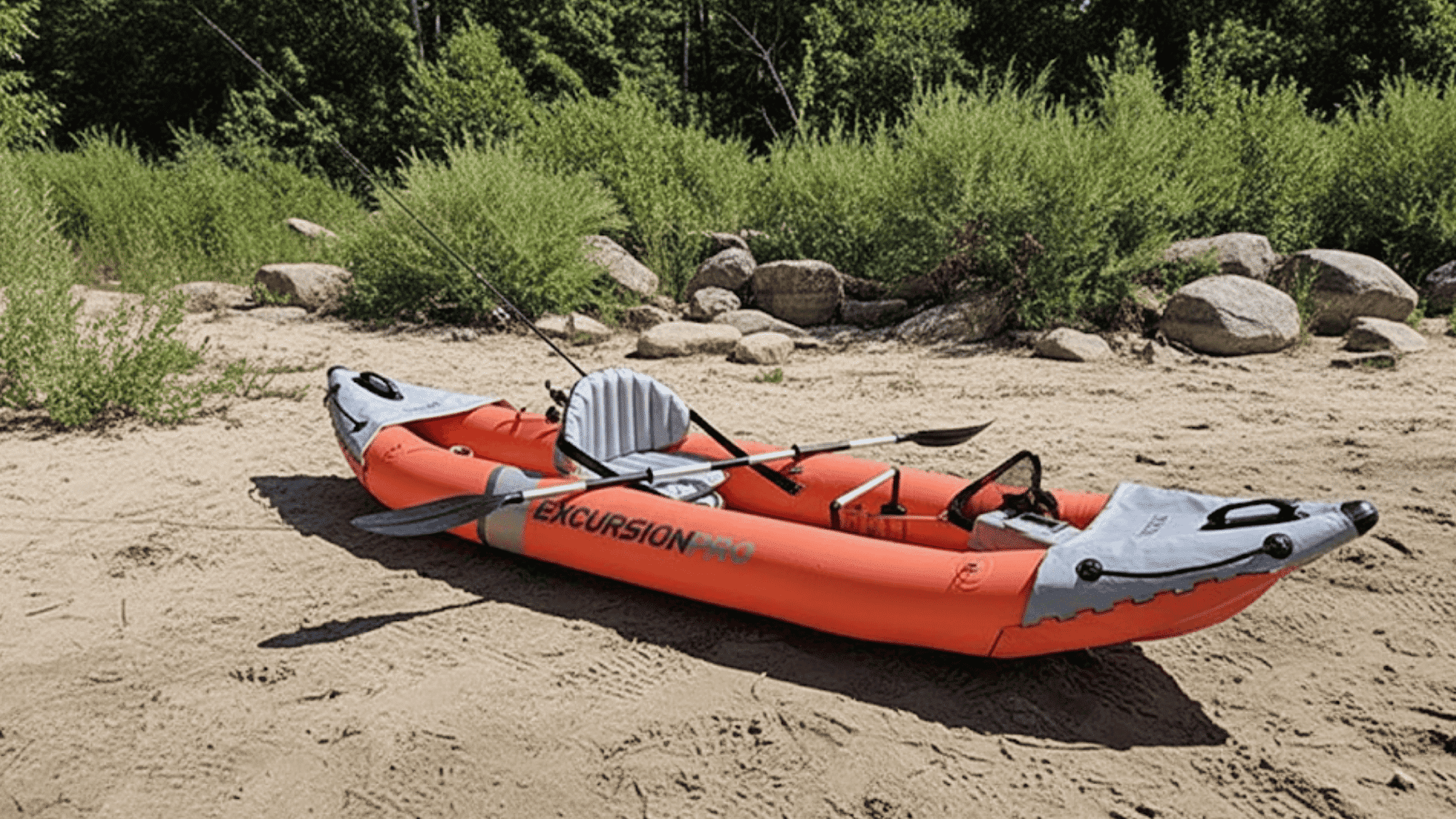Every year, kayaking accidents happen when paddlers think they don’t need safety gear.
Even experienced kayakers can find themselves in trouble when the weather changes fast or the equipment fails. The water doesn’t care how good someone thinks they are at swimming.
A proper life jacket can be the difference between a scary story and a tragic headline.
Smart paddlers know that wearing a Personal Flotation Device (PFD) isn’t just about following rules. It’s about getting home safe to plan the next adventure.
This guide breaks down everything kayakers need to know about life jacket laws, safety benefits, and how to pick the right gear.
From state regulations to the best PFD models, readers will have all the info they need to stay safe and legal on the water.
Do You Have to Wear a Life Jacket on a Kayak?
The U.S. Coast Guard requires all recreational kayaks to carry at least one approved Personal Flotation Device for each person on board.
However, the rules about actually wearing the PFD vary significantly by state and local jurisdiction. Some states require children to wear life jackets at all times, while others only require them to be accessible.
Federal law classifies kayaks as vessels, which means they fall under maritime safety regulations.
The Coast Guard sets minimum standards, but individual states can make stricter rules. This patchwork of regulations means kayakers need to check local laws before hitting the water.
More importantly, not following PFD laws can complicate insurance claims if an accident occurs. Smart paddlers treat these requirements as the bare minimum, not the safety standard.
Safety Benefits of Wearing a Life Jacket
Life jackets do more than just keep paddlers afloat when things go wrong. They offer multiple safety advantages that can save lives, even in situations where swimming ability is not a factor.
- Instant buoyancy – Works even when someone is unconscious or injured, providing immediate flotation with no effort required from the wearer.
- Enhanced visibility – Bright colors make kayakers easier to spot from rescue boats, helicopters, and other watercraft during emergencies.
- Energy conservation – Extra flotation helps paddlers conserve strength while waiting for help, preventing exhaustion in cold water.
- Proper head positioning – Modern PFDs keep the wearer’s head above water in the correct position, preventing drowning even if the wearer is unconscious.
- Cold water protection – Helps maintain body position when cold water rapidly drains strength and coordination from even strong swimmers.
The automatic safety features of a life jacket work regardless of swimming ability or water conditions.
State-by-State Life Jacket Laws and Regulations for Kayaking
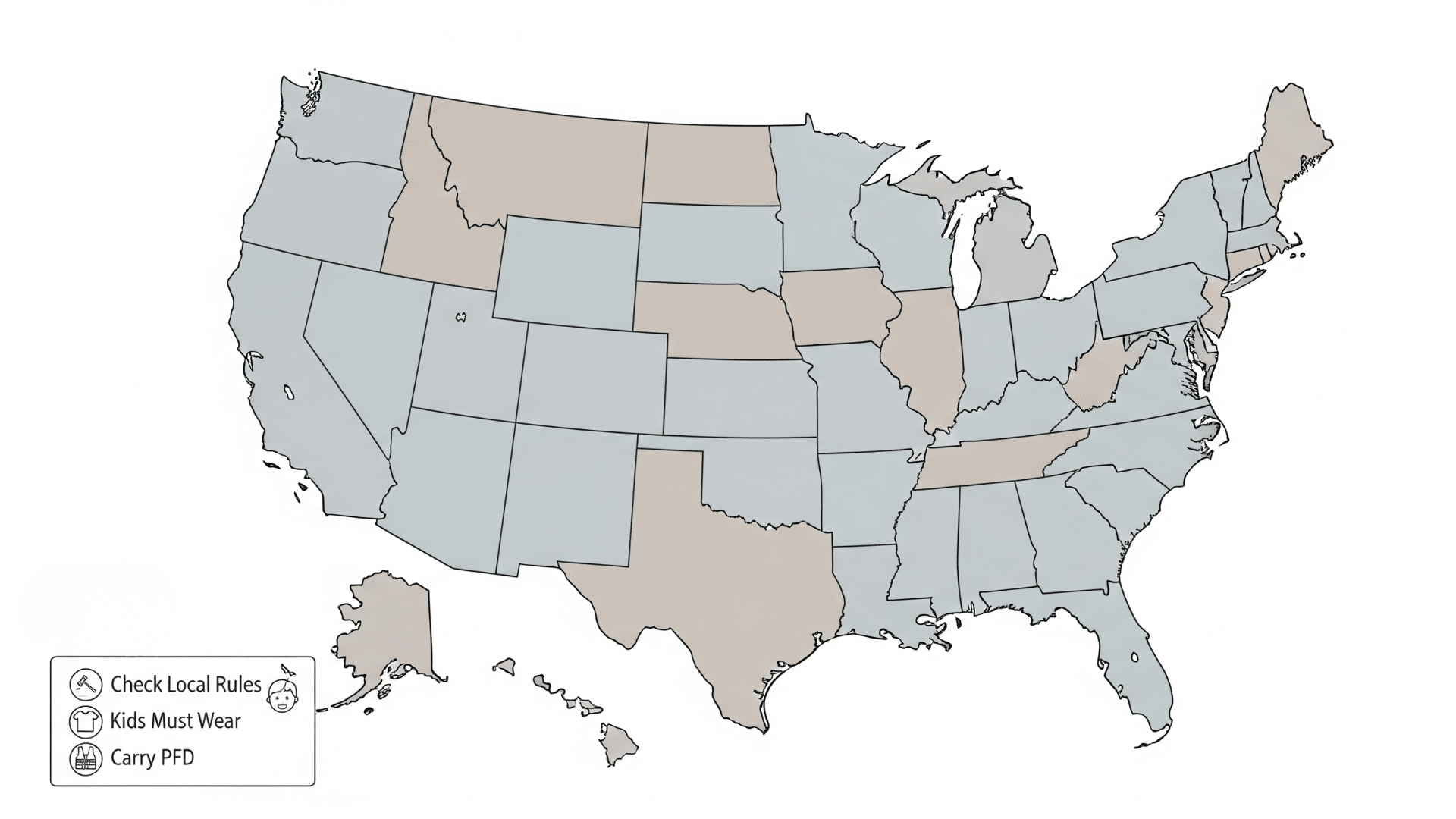
Life jacket laws change dramatically depending on where someone paddles. However, even in states with minimal requirements, local authorities strongly recommend wearing PFDs while paddling.
| S. No | State | Kayak Life Jacket Law | Minimum Age to Wear | Approved Life Jackets | When PFD Has to Be Worn by a Child | Vessel Length Requirement | Fine for Not Wearing |
|---|---|---|---|---|---|---|---|
| 1 | Alabama | Children under 8 must wear PFD, recommended for adults | Under 8 | USCG Types I, II, III | Children under 8 at all times | No specific length requirement | Varies by county, typically $50+ |
| 2 | Alaska | Children under 13 must wear PFD on open boats | Under 13 | USCG Types I, II, III, IV | Children under 13 when on open boats | No specific length requirement | Varies |
| 3 | Arizona | Some lakes require PFD wear at all times | Under 13 (varies) | USCG Types I, II, III | Children under 13 when required by water way | No specific length requirement | Location-dependent fines |
| 4 | Arkansas | Children under 13 must wear PFD | Under 13 | USCG Type III | Children under 13 at all times | No specific length requirement | Varies |
| 5 | California | Children under 13 must wear PFD | Under 13 | USCG Types I, II, III | Children under 13 at all times; stricter coastal rules | No specific length requirement | $100+ fines with additional penalties |
| 6 | Colorado | Children under 12 must wear PFD; PFD accessible on vessels ≤16 ft | Under 12 | USCG Types I, II, III, IV | Children under 12 at all times | Vessels ≤16 ft must have PFD readily accessible | $50-$200 |
| 7 | Connecticut | Children under 12 must wear year-round; others Sept-May | Under 12 | USCG Types I, II, III, V | Children under 12 always; others during Sep-May | No specific length requirement | Up to $500 |
| 8 | Delaware | Children under 13 must wear PFD | Under 13 | USCG Types I, II, III | Children under 13 at all times | No specific length requirement | Up to $100 |
| 9 | Florida | Children under 6 must wear PFD | Under 6 | USCG Types I, II, III | Children under 6 at all times | No specific length requirement | Up to $250 |
| 10 | Georgia | Children under 13 must wear PFD | Under 13 | USCG Types I, II, III | Children under 13 at all times | No specific length requirement | Up to $100+ |
| 11 | Hawaii | PFD worn recommended, mandatory for children under 13 | Under 13 | USCG Types I, II, III | Children under 13 at all times | No specific length requirement | Varies |
| 12 | Idaho | PFD must be accessible; children recommended to wear | Varies | USCG Types I, II, III | Children recommended to wear when on water | No specific length requirement | Varies |
| 13 | Illinois | No mandatory wear; PFD must be carried | No minimum | USCG Types I, II, III | N/A | No specific length requirement | Varies |
| 14 | Indiana | No mandatory wear; PFD must be carried | No minimum | USCG Types I, II, III | N/A | No specific length requirement | Varies |
| 15 | Iowa | No mandatory wear; PFD must be carried | No minimum | USCG Types I, II, III | N/A | No specific length requirement | Varies |
| 16 | Kansas | No mandatory wear; PFD must be carried | No minimum | USCG Types I, II, III | N/A | No specific length requirement | Varies |
| 17 | Kentucky | No mandatory wear; PFD must be carried | No minimum | USCG Types I, II, III | N/A | No specific length requirement | Varies |
| 18 | Louisiana | Children under 12 must wear PFD | Under 12 | USCG Types I, II, III | Children under 12 at all times | No specific length requirement | Varies |
| 19 | Maine | Children under 12 must wear PFD | Under 12 | USCG Types I, II, III | Children under 12 at all times | No specific length requirement | Varies |
| 20 | Maryland | Children under 13 must wear PFD | Under 13 | USCG Types I, II, III | Children under 13 at all times | No specific length requirement | Varies |
| 21 | Massachusetts | Children under 13 must wear PFD | Under 13 | USCG Types I, II, III | Children under 13 at all times | No specific length requirement | Varies |
| 22 | Michigan | Children under 13 must wear PFD | Under 13 | USCG Types I, II, III | Children under 13 at all times | No specific length requirement | Varies |
| 23 | Minnesota | No mandatory wear; PFD must be carried | No minimum | USCG Types I, II, III | N/A | No specific length requirement | Varies |
| 24 | Mississippi | Children under 13 must wear PFD | Under 13 | USCG Types I, II, III | Children under 13 at all times | No specific length requirement | Varies |
| 25 | Missouri | Children under 13 must wear PFD | Under 13 | USCG Types I, II, III | Children under 13 at all times | No specific length requirement | Varies |
| 26 | Montana | No mandatory wear; PFD must be carried | No minimum | USCG Types I, II, III | N/A | No specific length requirement | Varies |
| 27 | Nebraska | No mandatory wear; PFD must be carried | No minimum | USCG Types I, II, III | N/A | No specific length requirement | Varies |
| 28 | Nevada | No mandatory wear; PFD must be carried | No minimum | USCG Types I, II, III | N/A | No specific length requirement | Varies |
| 29 | New Hampshire | Children under 12 must wear PFD | Under 12 | USCG Types I, II, III | Children under 12 at all times | No specific length requirement | Varies |
| 30 | New Jersey | Children under 12 must wear PFD | Under 12 | USCG Types I, II, III | Children under 12 at all times | No specific length requirement | Varies |
| 31 | New Mexico | Children under 13 must wear PFD | Under 13 | USCG Types I, II, III | Children under 13 at all times | No specific length requirement | Varies |
| 32 | New York | No mandatory wear; PFD must be carried | No minimum | USCG Types I, II, III | N/A | No specific length requirement | Varies |
| 33 | North Carolina | Children under 13 must wear PFD | Under 13 | USCG Types I, II, III | Children under 13 at all times | No specific length requirement | Varies |
| 34 | North Dakota | No mandatory wear; PFD must be carried | No minimum | USCG Types I, II, III | N/A | No specific length requirement | Varies |
| 35 | Ohio | Children under 13 must wear PFD | Under 13 | USCG Types I, II, III | Children under 13 at all times | No specific length requirement | Varies |
| 36 | Oklahoma | Children under 13 must wear PFD | Under 13 | USCG Types I, II, III | Children under 13 at all times | No specific length requirement | Varies |
| 37 | Oregon | Children under 12 must wear PFD | Under 12 | USCG Types I, II, III | Children under 12 at all times | No specific length requirement | Varies |
| 38 | Pennsylvania | Children under 12 must wear PFD | Under 12 | USCG Types I, II, III | Children under 12 at all times | No specific length requirement | Varies |
| 39 | Rhode Island | Children under 12 must wear PFD | Under 12 | USCG Types I, II, III | Children under 12 at all times | No specific length requirement | Varies |
| 40 | South Carolina | Children under 13 must wear PFD | Under 13 | USCG Types I, II, III | Children under 13 at all times | No specific length requirement | Varies |
| 41 | South Dakota | No mandatory wear; PFD must be carried | No minimum | USCG Types I, II, III | N/A | No specific length requirement | Varies |
| 42 | Tennessee | Children under 13 must wear PFD | Under 13 | USCG Types I, II, III | Children under 13 at all times | No specific length requirement | Varies |
| 43 | Texas | Children under 13 must wear PFD | Under 13 | USCG Types I, II, III | Children under 13 at all times | No specific length requirement | Varies |
| 44 | Utah | Children under 12 must wear PFD; under 16 supervised | Under 12 | USCG Types I, II, III | Children under 12 at all times | No specific length requirement | Varies |
| 45 | Vermont | Children under 13 must wear PFD | Under 13 | USCG Types I, II, III | Children under 13 at all times | No specific length requirement | Varies |
| 46 | Virginia | Children under 13 must wear PFD | Under 13 | USCG Types I, II, III | Children under 13 at all times | No specific length requirement | Varies |
| 47 | Washington | Children under 13 must wear PFD | Under 13 | USCG Types I, II, III | Children under 13 at all times | No specific length requirement | Varies |
| 48 | West Virginia | No mandatory wear; PFD must be carried | No minimum | USCG Types I, II, III | N/A | No specific length requirement | Varies |
| 49 | Wisconsin | Children under 13 must wear PFD | Under 13 | USCG Types I, II, III | Children under 13 at all times | No specific length requirement | Varies |
| 50 | Wyoming | No mandatory wear; PFD must be carried | No minimum | Recommended Type III | N/A | No specific length requirement | Varies |
Types of Life Jackets Suitable for Kayaking
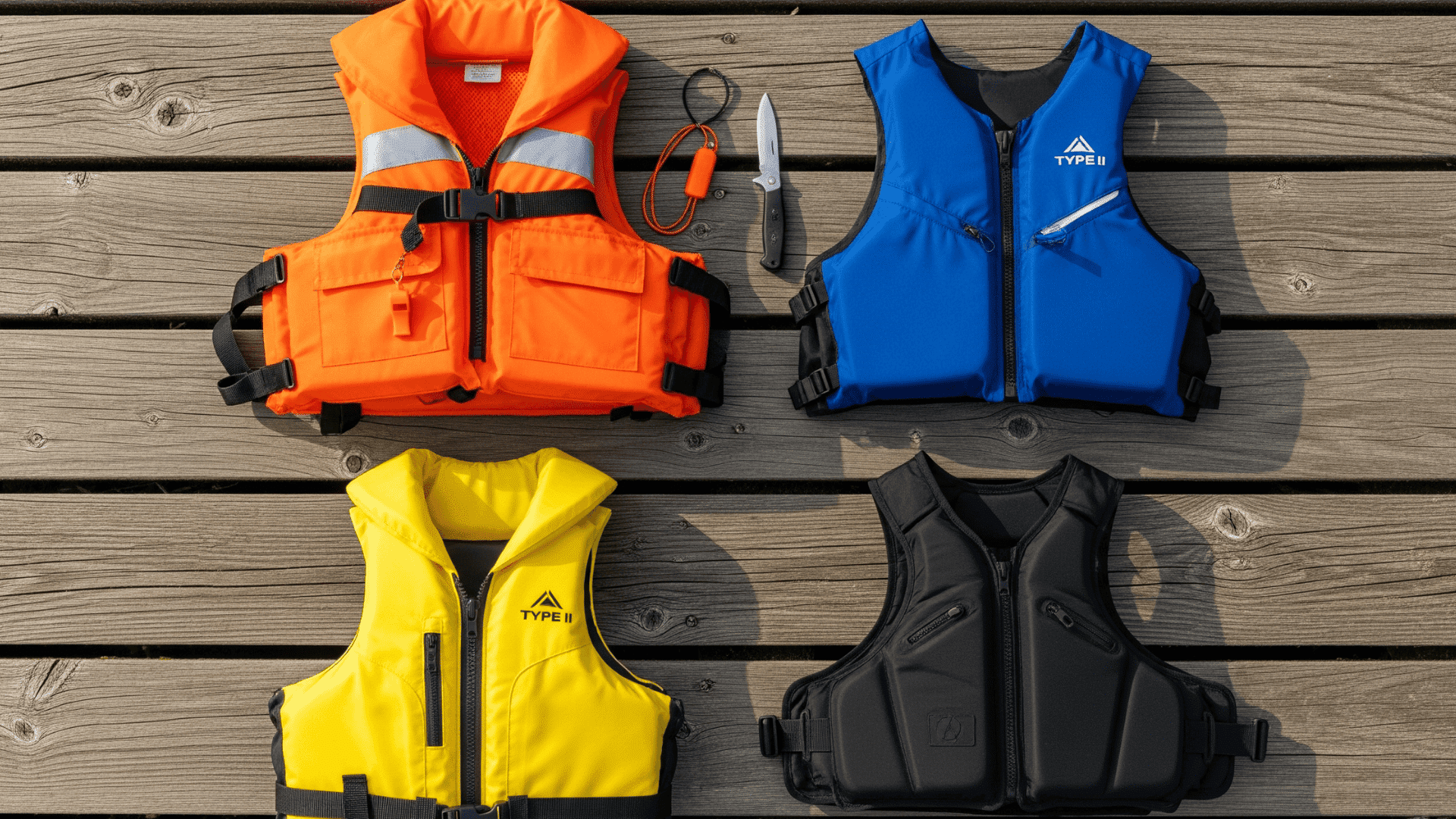
Personal Flotation Devices come in five main types, but only three work well for kayaking. Each type offers different benefits and trade-offs for paddlers.
1. Type I Life Jackets
Type I life jackets offer the most buoyancy and will turn an unconscious person face-up in the water. However, their bulk makes them impractical for most kayaking activities.
These are best reserved for offshore or rough water conditions where maximum safety takes priority over comfort.
2. Type II PFDs
Type II PFDs provide good flotation and will turn most unconscious wearers face-up.
They’re more comfortable than Type I but still bulkier than what most kayakers prefer. These work best for short trips in calm, protected waters.
3. Type III Life Jackets
Type III life jackets are the most popular choice for kayakers because they balance safety with comfort and mobility.
They provide excellent flotation but won’t necessarily turn an unconscious person face-up. The trade-off in automatic positioning is worth it for the increased comfort and range of motion while paddling.
4. Type IV PFDs
Type IV PFDs are throwable flotation devices, such as ring buoys or seat cushions, designed to be tossed to someone in the water.
They provide effective temporary flotation but must be held onto, which makes them impractical for kayakers. These are best suited for larger boats where crew members can quickly throw the device to someone who has fallen overboard.
5. Type V PFDs
Type V PFDs include specialized designs like inflatable life jackets that some kayakers prefer. These must be worn at all times to meet Coast Guard requirements.
They offer excellent mobility when not inflated, but require proper maintenance and inspection to function correctly.
How to Get a Life Jacket: Buying Guide and Recommendations
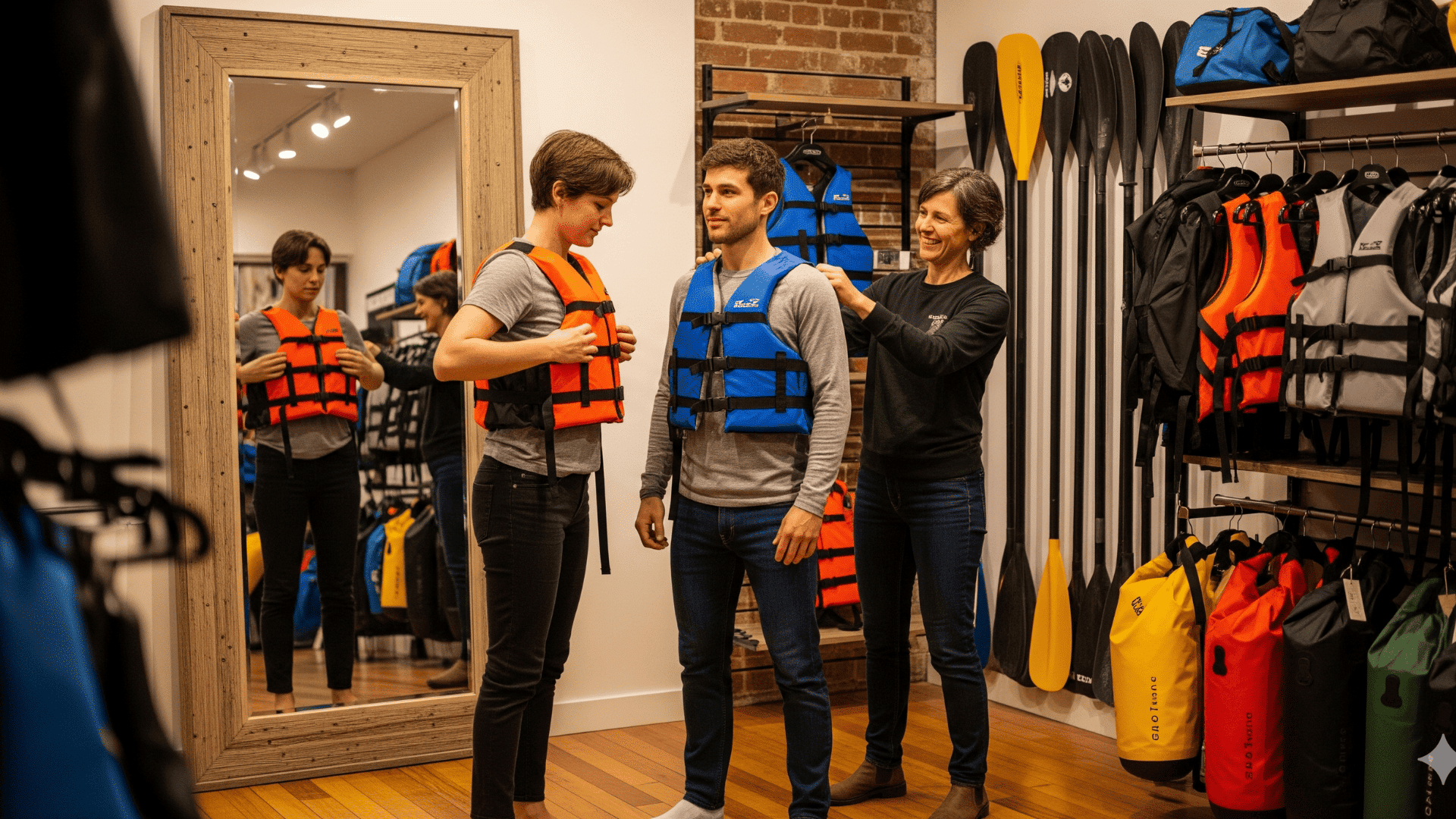
Quality outdoor retailers like REI, Dick’s Sporting Goods, and Bass Pro Shops carry extensive selections of kayaking PFDs.
Specialty kayak shops often provide better expertise and fitting services, while online marketplaces like Amazon offer convenience and competitive prices.
Buoyancy ratings for most Type III kayaking PFDs range from 15 to 22 pounds, with heavier paddlers requiring higher ratings.
Recommended Life Jackets:
|
All recommended models carry U.S. Coast Guard approval stamps and meet legal safety requirements.
Tips for Wearing and Using Life Jackets Properly
A life jacket only works when worn correctly and maintained properly. All straps and buckles should be fastened and adjusted for a snug fit.
Check all buckles, zippers, and straps before each trip. Look for signs of wear, UV damage, or loose stitching.
Store life jackets in a cool, dry place away from direct sunlight. Avoid folding or compressing the foam for long periods, as this can reduce buoyancy over time.
Replace any PFD that shows significant wear or damage to the foam or fabric.
Never use a life jacket as a seat cushion or fender. The compression can damage the foam and reduce its effectiveness. Similarly, avoid using the PFD to carry gear by stuffing items into the foam chambers.
Conclusion: Prioritize Safety
Life jacket laws exist because drowning remains a leading cause of boating fatalities. Even accomplished swimmers can find themselves in trouble when conditions change rapidly.
The few minutes it takes to properly fit and fasten a PFD can prevent a tragedy.
Smart kayakers don’t just meet the minimum legal requirements; they exceed them.
Wearing a properly fitted, Coast Guard-approved life jacket on every paddle shows respect for the water and responsibility toward family and fellow paddlers.
The slight inconvenience disappears quickly, but the safety benefit lasts the entire trip.


